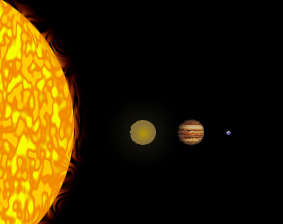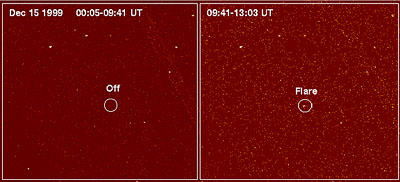Imagine the Universe News - 7 August 2000
CHANDRA CAPTURES FLARE FROM BROWN DWARF
| 07 August 2000 |

|
|
This illustration shows the size of our Sun (left) compared with a brown dwarf (second from left), Jupiter (third from left) and Earth (right).
(credit: Brian Hewitt/NASA GSFC) |
Brown dwarfs are objects smaller than our Sun and most other stars, but larger than gas giant planets like Jupiter and Saturn. Unlike stars, brown dwarfs have too little mass to sustain nuclear reactions in their cores, so they're very dim - less than a tenth of a percent as luminous as the sun. Their primary source of energy is the release of gravitational energy as they slowly contract. Brown dwarfs intrigue many astronomers because they are poorly understood and probably a very common class of objects. But because they are cool, dim objects, they rarely provide much for high-energy astronomers to observe.
A new image from NASA's Chandra X-ray Observatory may change that. Chandra recently detected the first flare ever seen from a brown dwarf. The bright X-ray flare has implications for understanding the explosive activity and origin of magnetic fields of extremely low mass stars.
Located in the constellation Fornax in the southern skies, LP 944-20 is one of the best studied brown dwarfs because it is only 16 light years from Earth. It's about 500 million years old and has a mass that is about 60 times that of Jupiter, or 6 percent that of the sun. Its diameter is about one-tenth that of the Sun and it has a rotation period of less than five hours.
Chandra detected no X-rays at all from LP 944-20 for the first nine hours of a twelve hour observation, then the source flared dramatically before it faded away over the next two hours. "We were shocked," said Dr. Robert Rutledge of the California Institute of Technology in Pasadena, the lead author on the discovery paper to appear in the July 20 issue of Astrophysical Journal Letters. "We didn't expect to see flaring from such a lightweight object. This is really the 'mouse that roared.'"
 |
| Chandra image of LP 944-20 before the flare (left) and during the 2-hour X-ray flare (right) |
The energy emitted in the brown dwarf flare was comparable to a small solar flare. It was a billion times greater than observed X-ray flares from Jupiter. The flaring energy is believed to come from a twisted magnetic field. "This is the strongest evidence yet that brown dwarfs and possibly young giant planets have magnetic fields, and that a large amount of energy can be released in a flare," said Dr. Eduardo Martin, also of Caltech and a member of the team.
Professor Gibor Basri of the University of California, Berkeley, the principal investigator for this observation, speculated that the flare "could have its origin in the turbulent magnetized hot material beneath the surface of the brown dwarf. A sub-surface flare could heat the atmosphere, allowing currents to flow and give rise to the X-ray flare -- like a stroke of lightning."
The absence of X-rays from LP 944-20 during the non-flaring period is in itself a significant result. It sets the lowest limit on steady X-ray power produced by a brown dwarf, and shows that the million degree Celsius upper atmospheres, or coronae, cease to exist as the surface temperature of a brown dwarf cools below about 2500 degrees Celsius.
"This is an important confirmation of the trend that hot gas in the atmospheres of lower mass stars is produced only in flares," said Professor Lars Bildsten of the University of California, Santa Barbara, also a member of the team.
The 12-hour observation of LP 944-20 was made on December 15, 1999, using the Advanced CCD Imaging Spectrometer (ACIS).
The ACIS instrument was built for NASA by the Massachusetts Institute of Technology, Cambridge, and Pennsylvania State University, University Park. NASA's Marshall Space Flight Center in Huntsville, Ala., manages the Chandra program. TRW, Inc., Redondo Beach, Calif., is the prime contractor for the spacecraft. The Smithsonian's Chandra X-ray Center controls science and flight operations from Cambridge, Mass.

